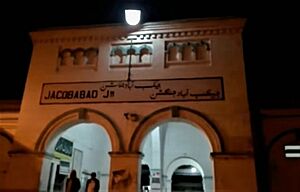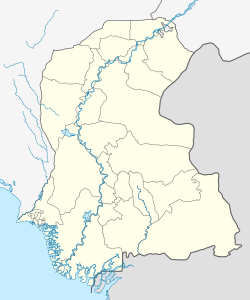Jacobabad facts for kids
Quick facts for kids
Jacobabad
|
|
|---|---|

Jacobabad Junction railway station
|
|
| Country | |
| Province | |
| Division | Larkana Division |
| District | Jacobabad District |
| Founded | 1847 |
| Population
(2023)
|
|
| • City | 219,315 |
| • Rank | 47th in Pakistan |
| Time zone | UTC+5 (PST) |
Jacobabad (Urdu: جیکب آباد and Sindhi: جيڪب آباد; formerly Khanger or Khangarh) is a city in Sindh, Pakistan, serving as both the capital city of Jacobabad District and the administrative centre of Jacobabad Taluka, an administrative subdivision of the district. The city itself is subdivided into eight Union Councils. Sitting far to the northwest of the province, near the provincial boundaries of Sindh and Balochistan, Jacobabad became a city on the site of an existing village (Khangarh), and is crossed by the Pakistan Railways and many main roads of the province. It is the 43rd most populous city in Pakistan.
The city is one of the hottest places on earth, with summer temperatures regularly rising to a mean temperature of 37 °C (99 °F). In particular, compounded by the humidity and climate change, Jacobabad has several times exceeded a wet-bulb temperature of 35 °C (95 °F), above which the human body cannot sufficiently cool itself. Jacobabad has been cited as one of the world's most vulnerable places to global warming, and one where the difference between 1.5 °C and 2 °C can be the difference between life and death.
Etymology
The city is named after Brigadier-General John Jacob CB (1812–1858), an officer of the British East India Company who ruled this region during the last decade of his life. He is also known for the cavalry regiment called 36th Jacob's Horse. Jacobs was a graduate of Addiscombe Military Seminary. He was commissioned into the Bombay Artillery (Bombay Army) on his 16th birthday, and subsequently sailed for India in January 1828, never to set foot in England again. According to travel writer Salman Rashid, it was local residents "who took to calling the new settlement ‘Jekumbad’", later renamed to Jacobabad by the British rulers. The scale of progress and prosperity Jacob's works brought to the region can be appreciated by comparing those regions' relative prosperity at the time, compared to areas which were not under his administrative jurisdiction.
History
In 1847 Jacob was placed in political charge of the frontier and established his headquarters at the village of Khangurh (or Khanger). He started building infrastructure for the town around the village. Being an architect and an engineer himself, he designed and then executed the plans of laying a wide road network around the town that measured a good 600 miles (965 km). In that he resolved the problem of unavailability of potable water for the residents by excavating a tank that contained water brought from Indus through a canal. His biggest and most important feat was the excavation of Begaree Canal, originating from Guddu barrage on river Indus, going round the district irrigating thousands of acres of land previously uncultivated, thereby providing means of living to thousands of people.
After the British Raj, the city was ruled by a Sardar, Taj Dero Khan Odho.
In November 2010, then Prime Minister Yousaf Raza Gillani announced that University of Information Technology would be established in Jacobabad.
Demographics
| Census | Population |
|---|---|
| 1972 | 57,596 |
| 1981 | 79,365 |
| 1998 | 138,780 |
| 2017 | 191,098 |
| 2023 | 219,315 |
Climate
Jacobabad has a hot desert climate (Köppen climate classification BWh) with extremely hot summers and mild winters. The city is well known for consistently having among the highest temperature in South Asia, with a mean summer temperature of 37 °C (99 °F). The highest recorded temperature is 52.8 °C (127.0 °F), and the lowest recorded temperature is −3.9 °C (25.0 °F). Rainfall is low and mainly occurs in the monsoon season (July–September). The average annual rainfall of Jacobabad is 202.5 mm as per 1991-2020 period. The highest annual rainfall ever is 838.7 mm, recorded in 2022, and the lowest annual rainfall ever is 3.3 mm, recorded in 1922.
In the 2022 South Asian heat wave, Jacobabad's mean temperature for the month of May broke the all-time record with 43 °C (109 °F), reaching or exceeding 50 °C (122 °F) on four days. The city struggles to provide heat-mitigation measures. Many residents who are able to, migrate to higher-elevation Quetta during the summer school break.
| Climate data for Jacobabad (1991–2020, extremes 1961–present) | |||||||||||||
|---|---|---|---|---|---|---|---|---|---|---|---|---|---|
| Month | Jan | Feb | Mar | Apr | May | Jun | Jul | Aug | Sep | Oct | Nov | Dec | Year |
| Record high °C (°F) | 30.6 (87.1) |
34.0 (93.2) |
42.1 (107.8) |
47.0 (116.6) |
52.8 (127.0) |
51.1 (124.0) |
47.8 (118.0) |
45.0 (113.0) |
42.8 (109.0) |
41.7 (107.1) |
38.0 (100.4) |
30.6 (87.1) |
52.8 (127.0) |
| Mean daily maximum °C (°F) | 22.0 (71.6) |
25.5 (77.9) |
31.4 (88.5) |
38.5 (101.3) |
43.8 (110.8) |
44.3 (111.7) |
40.2 (104.4) |
37.5 (99.5) |
36.5 (97.7) |
35.0 (95.0) |
29.9 (85.8) |
24.2 (75.6) |
34.1 (93.4) |
| Daily mean °C (°F) | 15.1 (59.2) |
18.5 (65.3) |
24.2 (75.6) |
30.7 (87.3) |
35.7 (96.3) |
37.1 (98.8) |
34.9 (94.8) |
33.1 (91.6) |
31.5 (88.7) |
28.1 (82.6) |
22.4 (72.3) |
16.9 (62.4) |
27.4 (81.3) |
| Mean daily minimum °C (°F) | 8.1 (46.6) |
11.5 (52.7) |
17.0 (62.6) |
22.8 (73.0) |
27.6 (81.7) |
30.0 (86.0) |
29.6 (85.3) |
28.5 (83.3) |
26.7 (80.1) |
21.1 (70.0) |
14.9 (58.8) |
9.5 (49.1) |
20.6 (69.1) |
| Record low °C (°F) | −1.1 (30.0) |
1.0 (33.8) |
6.0 (42.8) |
13.5 (56.3) |
18.9 (66.0) |
21.0 (69.8) |
20.3 (68.5) |
22.8 (73.0) |
17.8 (64.0) |
12.0 (53.6) |
3.9 (39.0) |
0.3 (32.5) |
−1.1 (30.0) |
| Average precipitation mm (inches) | 4.6 (0.18) |
8.4 (0.33) |
11.0 (0.43) |
4.9 (0.19) |
4.0 (0.16) |
26.8 (1.06) |
47.8 (1.88) |
54.5 (2.15) |
38.2 (1.50) |
1.6 (0.06) |
11.5 (0.45) |
8.7 (0.34) |
212.0 (8.35) |
| Average precipitation days (≥ 1.0 mm) | 1.2 | 1.6 | 1.9 | 1.0 | 0.7 | 0.7 | 1.9 | 1.7 | 0.6 | 0.3 | 0.3 | 0.9 | 12.8 |
| Mean monthly sunshine hours | 241.9 | 214.7 | 247.5 | 249.4 | 266.4 | 272.7 | 236.0 | 259.8 | 278.1 | 288.8 | 267.6 | 243.7 | 3,066.6 |
| Source: NOAA (sun 1961–1990) | |||||||||||||
Airport and airbase
The commercial airport at Jacobabad, about 500 kilometres (300 mi) north of Karachi and 500 km (300 mi) southeast of Kandahar, is located on the border between Sindh and Balochistan provinces. The Shahbaz Air Base (co-located with the commercial airport in Jacobabad) was one of three Pakistani air bases used by U.S. and allied forces to support the Operation Enduring Freedom campaign in Afghanistan and reportedly ongoing drone strikes in North Western Pakistan tribal regions.
See also
 In Spanish: Yacobabad para niños
In Spanish: Yacobabad para niños



